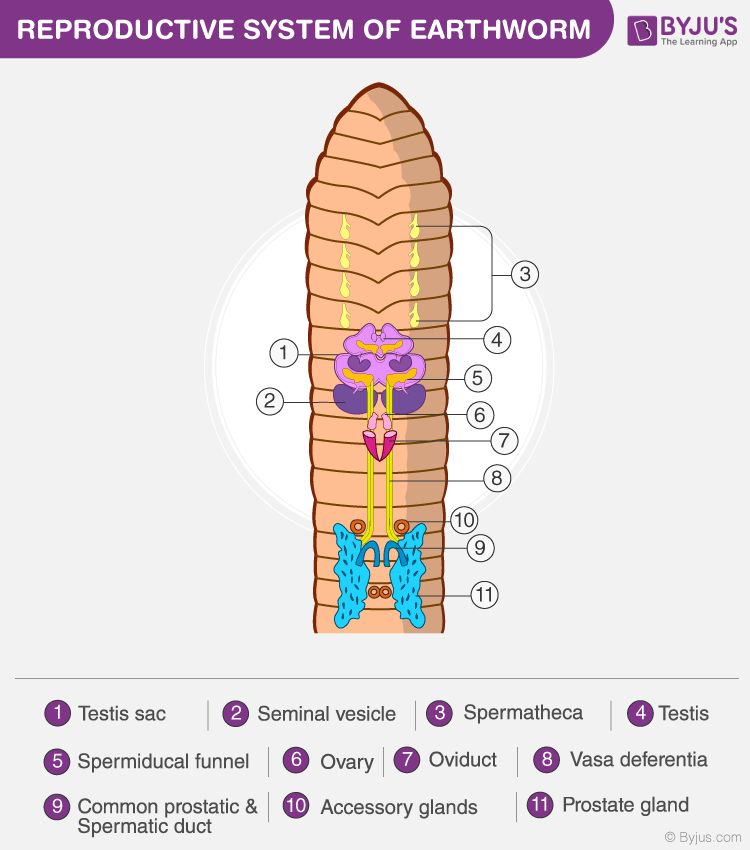An earthworm is a segmented worm; a terrestrial invertebrate belonging to the phylum Annelida. They are the common inhabitants of moist soil and feed on organic matter.
Earthworms are commonly called as farmer’s friend. This is because the worm casting (faecal deposit) increases the fertility and burrowing helps in proper aeration of the soil. The earthworms found in India are Pheretima and Lumbricus.
The morphology and anatomy of the earthworm are discussed below.
Earthworm Diagram
The diagram given below represents the morphological features of an earthworm.

Morphology of Earthworm
Earthworms have a tube-like arrangement or cylindrical shaped and reddish-brown segmented body. The body is divided into small segments. The dorsal side is characterized by a dark line of blood vessels and the ventral side is characterized by the genital openings. The mouth and the prostomium (an organ helps in burrowing) distinguish the anterior end.
The segments 14-16 of a matured earthworm consist of a glandular tissue called clitellum which helps us to distinguish the mouth and tail ends. The body is divided into three segments with respect to clitellum- preclitellar, clitellar and postclitellar.
Earthworms are hermaphrodites i.e., they carry both male and female sex organs. Segments 5-9 accommodate four pairs of spermathecal apertures. The female genital pore is situated at the 14th segment and a pair of male genital pores is situated at the 18th segment. The body consists of S-shaped setae, which help in locomotion in the earthworm. Setae are present in each segment except in the first, last and clitellum segments.
Recommended Video:

Anatomy of Earthworm
Externally, a thin non-cellular cuticle covers the body wall of the earthworm. Underneath this cuticle, a layer of the epidermis, followed by two muscle layers and coelomic epithelium (inner layer) is sheathed. The epithelium consists of a single layer of glandular columnar epithelium.
Digestive System
The alimentary canal is a long tube running from first to the last segment of the body. The food of earthworms is the leaves and decaying organic matters which are mixed with soil.
According to the diet, the parts of the alimentary canal and their secretion differ from other organisms. The alimentary canal begins at the mouth (buccal or oral cavity) (1-3 segments), passes through the pharynx, oesophagus (5-7 segments), muscular gizzards (8-9 segments), stomach (9-14 segments), intestines, and finally ends at the anus. The food particles get digested gradually as they travel through various compartments of the alimentary canal.
The muscular gizzards grind the soil particles and other matters and at the stomach, the humic acid of the hummus gets neutralized by the calciferous glands present in them. The typhlosole (26-35segments) present in the intestine increases the surface area for absorption.
Circulatory System
Earthworms have a closed circulatory system, constituting a heart, blood vessels, and capillaries. The segments 4-6 consist of blood glands that help in the production of blood cells and haemoglobin.
Respiratory System
Earthworms lack a well-developed structure for respiration. They respire through their moist skin by diffusion.
Excretory System
Nephridium is coiled tubules that regulate the volume and composition of the body fluids and thus, act as the excretory organ in earthworms. Nephridia are arranged in three segments- septal (15-last segments), integumentary (3-last segments) and pharyngeal nephridia (4-6 segments). A funnel that is connected to nephridia delivers wastes and excess fluid and is excreted out via the digestive tube.
Nervous System
The sensory input and muscular responses are controlled by the ganglia which are arranged segment-wise in the organism. These ganglia, on the paired nerve cord, make up the nervous system of the earthworms.
Sensory System
Although earthworms lack eyes they have specialized receptor cells to recognize the changes around them. Specialised sensory organs and chemoreceptors help them to respond to stimuli perfectly. The sensory system of the earthworms is present in the anterior portion of the body.
Reproductive System
Earthworms are bisexual. Hence, each individual carries both male and female reproductive systems in them.
The male reproductive system consists of two pairs of testes (10-11 segments), vasa deferentia (till 18th segment), and two pairs of accessory glands (17th and 19th segments). The prostate and spermatic ducts open by a pair of male genital pores (18th segment). The spermatozoa are stored in the four pairs of spermathecae (6-9 segments).
The female reproductive system consists of one pair of ovaries and oviduct. Ovaries open into an ovarian funnel running below the ovaries and join the oviduct and open at female genital pore (14thsegment).

During copulation, two earthworms exchange their sperms. Then, the collected sperm and egg and the nutritive fluids are deposited in the cocoon, which is later deposited into the soil.
Stay tuned with BYJU’S to learn more about morphology, diagram and anatomy of an earthworm.

what is earth worms class and order ?
Class: Clitellata
Order: Haplotaxids
Oligochaeta and Opisthopora
I really admired its a lots, and it’s very interested and its gave me satisfactory answer
This is very comprehensive